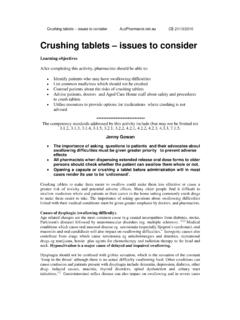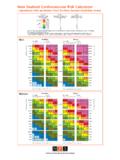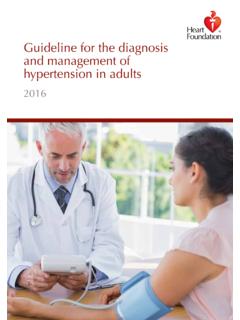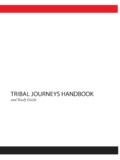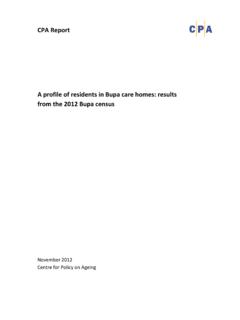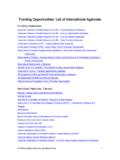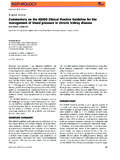Transcription of Dysphagia and crushing medications - Auspharm
1 Auspharm CPD Dysphagia and crushing medications 6/03/2014 pharmacy s home page - this CPD is online at Dysphagia and crushing medications crushing medications in Aged Care Facilities is very common in a high care environment but crushing medications is becoming more common in the community, with pharmacists not being aware that this practice is happening. Many patients are unable to swallow tablets whole and either cut them in half or smaller or crush them, or have them crushed by carers, in order to ingest them. Learning objectives After completing this activity, pharmacists should be able to: Determine if a person can swallow prescribed medications Provide strategies to assist swallowing Research accurate information to assist decision making as to safety to crush or not Identify those products which should not be crushed or chewed Suggest alternative dose forms or products to prescribers, nursing staff and patients where appropriate.
2 The 2010 Competency Standards addressed by this activity include (but may not be limited to): , , , , , , , , Successful completion of this activity is demonstrated by answering eight of the ten multiple choice questions correctly. This activity has been accredited for hours of Group One CPD (1 CPD Credit) that may be converted to 3 Group Two CPD Credits upon successful completion of the corresponding assessment for inclusion on an individual pharmacist's CPD Record. Accreditation number: A1403AP0. Under the auspices of the Australian Pharmacy Council, the Australian College of Pharmacy may accredit continuing professional development for pharmacists that is eligible to be used as supporting evidence of continuing competence.
3 The competency standards addressed by this activity include (but may not be limited to) , , , , , , , Author: Jenny Gowan PhD, Grad Dip Comm Pharm, PhC, FACPP, FPS, AACPA, MSHPA Jenny is a consultant pharmacist to the North East Valley Division of General Practice in Victoria working with Chronic Disease State Management. She originally trained in New Zealand and completed her PhD at Monash University Her areas of interest include: aged care, asthma, arthritis, drugs and driving, new drugs and guidelines, non-prescription medicines, primary health care, medication management, medical and pharmacy education. She has presented hundreds of lectures, in Victoria, Australia and internationally.
4 She has published over 280 papers and educational articles, one book, and three book chapters. Jenny, a practicing pharmacist, is a Special Lecturer in the Faculty of Pharmacy and Pharmaceutical Sciences, Monash University and also an Advisory Group member for the Bachelor of Pharmacy course. She is an accredited consultant pharmacist, and conducts her own company focussing on medication reviews in domiciliary and Aged Care Homes, education, training, government and industry consultation. She was recently awarded the Sanofi-Aventis Gold Medal by the University of Sydney Pharmacy Practice Foundation for excellence in Pharmacy Practice. Auspharm gratefully acknowledges the financial support provided by the sponsors of our CE program, MIMS Auspharm CPD Dysphagia and crushing medications 6/03/2014 pharmacy s home page - this CPD is online at Introduction crushing medications in Aged Care Facilities is very common in a high care environment but crushing medications is becoming more common in the community, with pharmacists not being aware that this practice is happening.
5 Many patients are unable to swallow tablets whole and either cut them in half or smaller or crush them, or have them crushed by carers, in order to ingest them. All pharmacists when dispensing extended release oral dose forms to older persons should check whether the patient can swallow the medicines whole or not. This must be an essential question of medication counselling and every medication review. The ability to swallow impacts not only on medications but also on nutritional requirements. Dysphagia (difficult swallowing) Chewing, swallowing, tasting, and communicating require intact, coordinated neuromuscular function in the mouth, face, and neck.
6 Oral motor function in particular declines measurably with aging, even in healthy people (1). Decline in function may have many manifestations: Reduction in masticatory muscle strength and coordination is common, especially in patients with partial or complete dentures, and may lead to a tendency to swallow larger food particles, which can increase the risk of choking or aspiration. Drooping of the lower face and lips caused by decreased muscle tone and reduced bone support, is an aesthetic concern and can lead to drooling, spilling of food and liquids, and difficulty closing the lips while eating, sleeping, or resting. Saliva leakage (sialorrhea) is often the first symptom.
7 Swallowing difficulties increase with ageing. It takes longer to move food from mouth to oropharynx, which increases the likelihood of aspiration. After age-related changes, the most common causes of oral motor disorders are neuromuscular disorders ( cranial neuropathies from diabetes, stroke, Parkinson's disease, amyotrophic lateral sclerosis, multiple sclerosis). Iatrogenic causes also contribute. Drugs ( anticholinergics, diuretics), radiation therapy to the head and neck, and chemotherapy can greatly impair saliva production. Hyposalivation is a major cause of delayed and impaired swallowing. (1) Some of the signs and symptoms of Dysphagia are: coughing, choking, drooling, repeated swallowing, gurgling voice and pocketing of food in the cheeks.
8 It is usually associated with a sensation of hold-up of the swallowed bolus and is sometimes accompanied by pain (odynophagia) (2). The origin of Dysphagia results from either structural or neuromuscular disease of the pharynx or oesophagus. Oropharyngeal Dysphagia is usually related to neuromuscular dysfunction, is localised to the neck and is commonly caused by stroke. It may also be associated with postnasal regurgitation, cough, and a need to repeatedly swallow to clear the pharynx. A pharyngeal pouch usually causes regurgitation of undigested food and gurgling may be audible over the side of the neck. (2) A modified barium swallow is used to confirm diagnosis (3).
9 Oesophageal Dysphagia is usually due to motor disorders, such as achalasia, a disorder of oesophageal motility, or diffuse oesophageal spasm where the muscle cannot relax, and to peptic oesophageal strictures often secondary to reflux (2). Diagnosis is by endoscopy (3). These patients report difficulty initiating swallowing, food sticking and regurgitation. There may be a delayed (15- 30 seconds) sense of hold-up where patients attempt to wash the offending bolus down with fluids. This may result in regurgitation (3). Patients experience pain on swallowing solid foods especially meat, potatoes and bread and then eventually liquids. Oesophageal spasm can mimic the features of angina and may be relieved partially by sublingual nitrates, Dysphagia should not be confused with globus sensation, which is the sensation of the constant lump in the throat although there is no actual difficulty swallowing food.
10 Other conditions can cause confusion and present Auspharm CPD Dysphagia and crushing medications 6/03/2014 pharmacy s home page - this CPD is online at with Dysphagia depression, diabetes, drug- induced causes, anaemia, thyroid disorders, spinal dysfunction and urinary tract infections. Malignant oesophageal obstruction is usually evident when there is a short history of rapidly progressive Dysphagia and significant weight loss. (2) Common causes of Dysphagia are listed in table 1. Table 2 lists some causes of drug-induced oesophageal ulceration. Insufficient fluid taken with tablets may cause irritation and is common in older persons.
